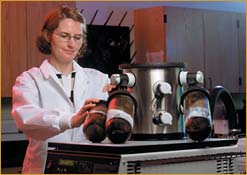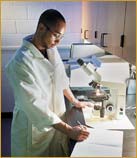

 |
| University Establishes Environmental
Molecular Science Institute Created in July 2002 and funded by the National Science Foundation and the Department of Energy, the Environmental Molecular Science Institute (EMSI) at Notre Dame is one of six such facilities in the country. The goal of EMSI is to bring engineers and scientists together in order to better understand, model, and predict the interaction between microparticles and heavy metals in the environment. “Although invisible to the human eye, we know there are nano- and microparticles in the ground,” says Jeremy B. Fein, professor of civil engineering and geological sciences and director of the newly created institute. “What we’ve found is that these microparticles interact both with the minerals that make up the geologic matrix and with dissolved contaminants. In fact, they strongly influence how metals, organic solvents, and other contaminants are distributed in soil and groundwater aquifers.” While groundwater is generally considered a safe source of drinking water, pollutants from a variety of sources, including landfills, chemical storage tanks, agricultural operations, hazardous waste sites, and mining operations, threaten to contaminate water supplies. The interaction between microparticles and other substances in the environment -- such as the process of bacteria binding heavy metals or actinides -- is one of three focal points of EMSI. The institute is also studying natural organic matter and mineral aggregates and their roles in the environment. “Perhaps the most important task we have,” says Fein, “is to accurately model the transport and fate of contaminants in the environment. It is obvious from the poor record in cleaning up Super Fund sites that no one fully understands the molecular-scale chemistry occurring at contaminated sites. EMSI researchers are working to develop models that can be used to make groundwater cleanup efforts more efficient and to design more effective containment treatment strategies.”  All activities in the institute, whether focusing on organic or inorganic
systems, integrate traditional macroscopic and microscopic techniques
with state-of-the-art molecular-scale approaches, such as X-ray adsorption
spectroscopy, atomic force microscopy, and molecular dynamics modeling.
Researchers, centered at the University, are working closely with their
counterparts at Argonne, Oak Ridge, and Sandia National laboratories
and DuPont Engineering Technology. These collaborative efforts pool expertise
from a wide range of environmental sciences, including aqueous and organic
chemistry, actinide chemistry, environmental engineering, hydrology,
microbiology and geomicrobiology, mineralogy, molecular dynamics modeling,
physics, and surface chemistry. All activities in the institute, whether focusing on organic or inorganic
systems, integrate traditional macroscopic and microscopic techniques
with state-of-the-art molecular-scale approaches, such as X-ray adsorption
spectroscopy, atomic force microscopy, and molecular dynamics modeling.
Researchers, centered at the University, are working closely with their
counterparts at Argonne, Oak Ridge, and Sandia National laboratories
and DuPont Engineering Technology. These collaborative efforts pool expertise
from a wide range of environmental sciences, including aqueous and organic
chemistry, actinide chemistry, environmental engineering, hydrology,
microbiology and geomicrobiology, mineralogy, molecular dynamics modeling,
physics, and surface chemistry.“According to our initial investigations, there appears to be a common structure in the bacterial cell wall that will make predicting interactions much easier,” says Fein. “We anticipate that the insights we have already gained and the information we have yet to uncover will continue to provide clues to responsible and economic ways to protect the environment and preserve it for future generations.” |